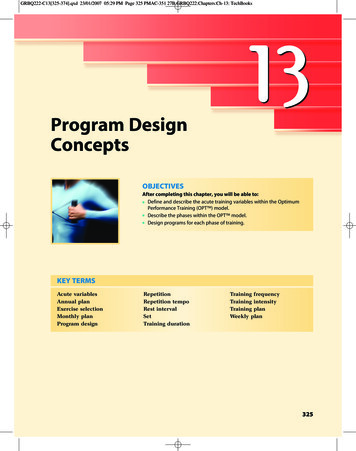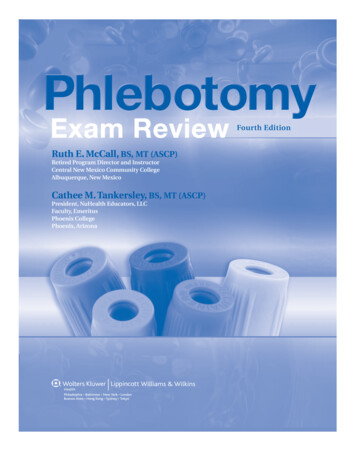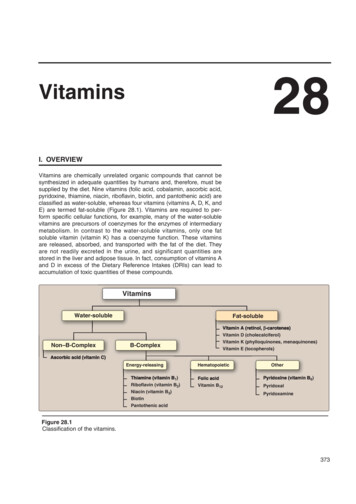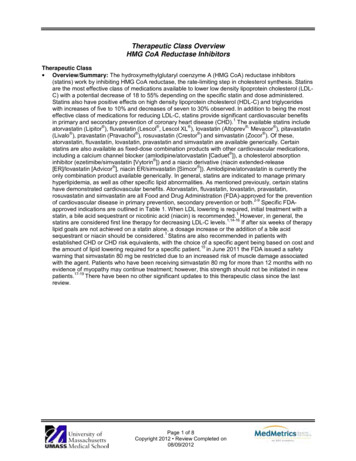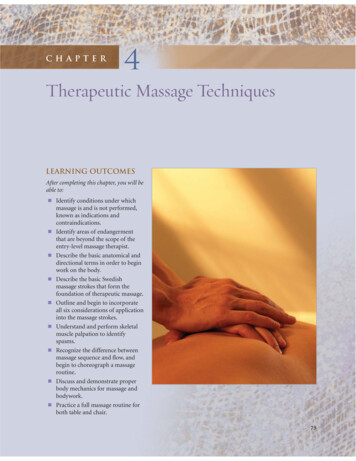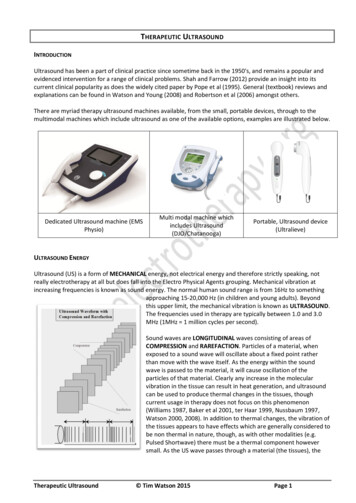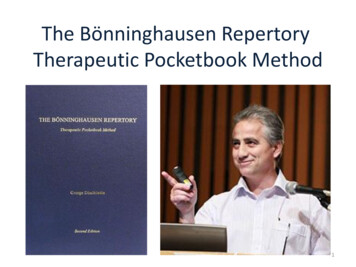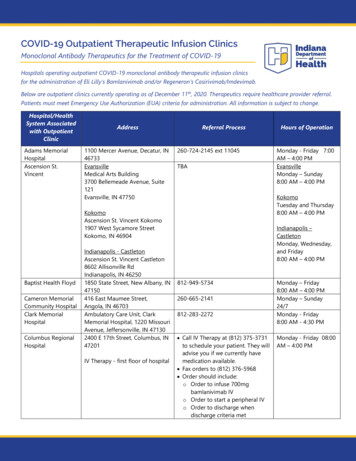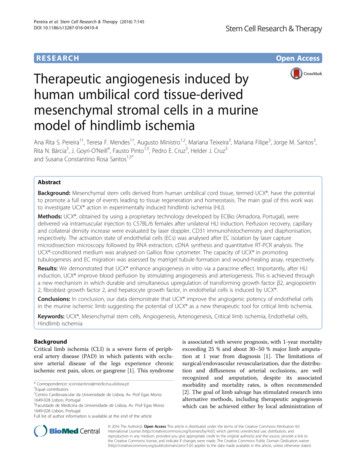
Transcription
THERAPEUTICEXERCISEMOVING TOWARDFUNCTION4thEDITION
Lori Thein Brody, PT, PhD, SCS, ATCSenior Clinical Specialist, Sports and Spine Physical TherapyUW HealthResearch Park ClinicMadison, WisconsinProfessorRocky Mountain University of Health ProfessionsProvo, UtahCarrie M. Hall, PT, MHSPhysical TherapistPresident, Movement Systems Physical Therapy, P.S.Clinical FacultyUniversity of WashingtonSeattle, Washingtonwith contributors
Acquisitions Editor: Michael NobelProduct Development Editor: John LarkinMarketing Manager: Shauna KelleyProduction Project Manager: David OrzechowskiDesign Coordinator: Stephen DrudingManufacturing Coordinator: Margie OrzechPrepress Vendor: S4Carlisle Publishing ServicesFourth editionCopyright 2018 Wolters Kluwer.Copyright 2009, 2005, 2002 Wolters Kluwer Health/Lippincott Williams & Wilkins. All rightsreserved. This book is protected by copyright. No part of this book may be reproduced or transmitted in any form or by any means, including as photocopies or scanned-in or other electronic copies,or utilized by any information storage and retrieval system without written permission from thecopyright owner, except for brief quotations embodied in critical articles and reviews. Materials appearing in this book prepared by individuals as part of their official duties as U.S. government employees are not covered by the above-mentioned copyright. To request permission, please contactWolters Kluwer at Two Commerce Square, 2001 Market Street, Philadelphia, PA 19103, via emailat permissions@lww.com, or via our website at lww.com (products and services).9 8 7 6 5 4 3 2 1Printed in ChinaLibrary of Congress Cataloging-in-Publication DataNames: Brody, Lori Thein, author. Hall, Carrie M., author.Title: Therapeutic exercise : moving toward function / Lori Thein Brody,Carrie M. Hall ; with contributors.Description: Fourth edition. Philadelphia : Wolters KluwerHealth/Lippincott Williams & Wilkins, [2018] Includes bibliographicalreferences and index.Identifiers: LCCN 2016055435 ISBN 9781496302342Subjects: MESH: Exercise Therapy—methodsClassification: LCC RM725 NLM WB 541 DDC 615.8/2—dc23 LC record available athttps://lccn.loc.gov/2016055435This work is provided “as is,” and the publisher disclaims any and all warranties, express or implied,including any warranties as to accuracy, comprehensiveness, or currency of the content of thiswork.This work is no substitute for individual patient assessment based upon health care professionals’examination of each patient and consideration of, among other things, age, weight, gender, currentor prior medical conditions, medication history, laboratory data and other factors unique to the patient. The publisher does not provide medical advice or guidance, and this work is merely a reference tool. Health care professionals, and not the publisher, are solely responsible for the use of thiswork including all medical judgments and for any resulting diagnosis and treatments.Given continuous, rapid advances in medical science and health information, independent professional verification of medical diagnoses, indications, appropriate pharmaceutical selections anddosages, and treatment options should be made, and health care professionals should consult a variety of sources. When prescribing medication, health care professionals are advised to consult theproduct information sheet (the manufacturer’s package insert) accompanying each drug to verify,among other things, conditions of use, warnings and side effects and identify any changes in dosageschedule or contraindications, particularly if the medication to be administered is new, infrequentlyused, or has a narrow therapeutic range. To the maximum extent permitted under applicable law,no responsibility is assumed by the publisher for any injury and/or damage to persons or property,as a matter of products liability, negligence law or otherwise, or from any reference to or use by anyperson of this work.LWW.com
To my father, Jack, whose motto“Never say can’t; do it and say it was hard”has sustained me throughout my life,and is carried forward by his grandchildren Nathaniel,Louisa, Benjamin, and Ethan.—Lori Thein BrodyI would like to dedicate this book tomy three daughters, Caroline, Gabrielle, and Jillian,who encourage me daily to be my best; my patients, who continuouslyteach me about the complexity of the movement system;my amazing colleagues who challenge me to stay currentand maintain a growth mind-set;and my mother Carol,who lived her life with courage and resolve and continues toserve as my daily inspiration.—Carrie M. Hall
ContributorsKimberly D. Bennett, PT, PhDPhysical Therapist and Lecturer with the Department ofRehabilitation MedicineUniversity of WashingtonOwner Liberty Physical Therapy, PLLCSeattle, WashingtonLisa M. Flexner, DPT, DMT, CSCS, FAAOMPTPhysical TherapistFocus Physical TherapyPart-time Instructor, Kinesiology ProgramOregon State University - CascadesBend, OregonJanet R. Bezner, PT, DPT, PhDAssociate ProfessorDepartment of Physical TherapyTexas State UniversitySan Marcos, TexasColin R. Grove, PT, MS, NCSPhysical TherapistDepartment of Orthopaedics and RehabilitationNeuro Outpatient RehabilitationUW Health Rehabilitation ClinicMiddleton, WisconsinElizabeth A. V. Bloom, PT, DPTPhysical Therapist, Advanced ClinicianUW Health Department of Orthopedics andRehabilitationSpine Physical TherapyUniversity of Wisconsin Hospital and ClinicsMadison, WisconsinLori Thein Brody, PT, PhD, SCS, ATCSenior Clinical Specialist, Sports and SpinePhysical TherapyUW HealthResearch Park ClinicMadison, WisconsinProfessorRocky Mountain University of Health ProfessionsProvo, UtahJudith Dewane, PT, DSc, NCSAssistant Professor (CHS)Physical Therapy ProgramDepartment of Orthopedics andRehabilitation MedicineUW Health Department of Orthopedics and RehabilitationMadison, WisconsinRafael F. Escamilla, PhD, PT, CSCS, FACSMProfessorDepartment of Physical TherapyCalifornia State University, SacramentoSacramento, CaliforniaResults Physical Therapy and Training CenterSacramento, CaliforniaMelissa Fischer, DPTPhysical Therapist, Advanced ClinicianUW Health Department of Orthopedics andRehabilitationSports Physical TherapyUniversity of Wisconsin Hospital and ClinicsMadison, WisconsinCarrie M. Hall, PT, MHSPhysical TherapistPresident, Movement Systems Physical Therapy, P.S.Clinical FacultyUniversity of WashingtonSeattle, WashingtonDarlene Hertling, PT, RetiredLecturer, Division of Physical TherapyDepartment of Rehabilitation MedicineUniversity of Washington School of MedicineSeattle, WashingtonSherri S. Holt, PT, DPT, MHSc, MTC, FAAOMPTPhysical TherapistUW Health Department of Orthopedics and RehabilitationSpine Physical TherapyUniversity of Wisconsin Hospital and ClinicsMadison, WisconsinAdjunct Instructor, Transitional Doctor of Physical TherapyRehabilitation SciencesUniversity of St. Augustine for Health SciencesSt. Augustine, FloridaCarol N. Kennedy, BScPT, MClSc (Manipulative Therapy),FCAMPTClinical Specialist - MSKPhysical TherapistPartner, Treloar Physiotherapy ClinicVancouver, British ColumbiaDanny McMillian, PT, DSc, OCS, CSCSClinical Associate ProfessorPhysical Therapy ProgramUniversity of Puget SoundTacoma, WashingtonJill McVey, DPT, ATCPhysical TherapistMovement Systems Physical Therapy, P.S.Seattle, Washington
CONTR I BUTOR SElizabeth R. Shelly, PT, DPT, WCS, BCB-PMDPhysical TherapistBoard certified specialist in women’s healthBeth Shelly Physical TherapyMoline, IllinoisM. J. Strauhal, PTPhysical TherapistClinical Specialist in OB-GYN and Women’s HealthProvidence St. Vincent Medical Center Rehabilitation ServicesPortland, OregonScott Tauferner PT, ATCPhysical Therapist, Advanced ClinicianUW Health Department of Orthopedics and RehabilitationUniversity of Wisconsin Hospital and ClinicsMadison, WisconsinJill Thein-Nissenbaum, PT, DSc, SCS, ATCAssociate ProfessorUniversity of Wisconsin-MadisonDoctor of Physical Therapy ProgramMadison, WisconsinStaff PT, UW AthleticsBadger Sports MedicineMadison, WisconsinKyle M. Yamashiro, PT, CSCSPresidentResults Physical Therapy and Training CenterMedical Adjunct FacultySacramento State UniversityProgram CoordinatorSF Giants Sports Medicine ConferencePhysical Therapist ConsultantSacramento River CatsRehab and Strength and Conditioning ConsultantSacramento Republic FCRehab ConsultantOakland A’svii
ReviewersThe publisher and authors gratefully acknowledge the manyprofessionals who shared their expertise and assisted in developing this textbook, appropriately targeting our marketingefforts, creating useful ancillary products, and setting the stagefor subsequent editions. These individuals include:Yasser Salem, PT, PhD, NCS, PCSAssociate ProfessorPhysical TherapyUniversity of North Texas Health Science CenterFort Worth, TexasFOURTH EDITIONMary Kay Solon, PT, MSDepartment Chair, ProfessorPhysical Therapist Assistant StudiesUniversity of Saint FrancisFort Wayne, IndianaEllen Anderson, PT, MA, GCSAssociate ProfessorRutgers School of Health ProfessionsNewark, New JerseySuzanne Brown, PT, MPH, PhDCollege of Health and Human ServicesSchool of Physical TherapyTouro University NevadaHenderson, NevadaMarcey Keefer Hutchison, PT, DPT, SCS, ATC, CMPAssistant Professor of Physical TherapyGeorge Fox UniversityNewberg, OregonJoseph Kelly, MSPTAssistant ProfessorDepartment of Physical Therapy & Health ScienceBradley UniversityPeoria, IllinoisJiu-Jenq Lin, PhD, PTSchool of Physical TherapyNational Taiwan UniversityTaipai City, TaiwanDaniel McGovern, PT, DPT, SCSAssistant Professor of Physical TherapySchool of Physical TherapyMassachusetts College of Pharmacy and Health SciencesUniversityWorcester, MassachusettsDawn Roberts, PT, PhDDepartment of Physical TherapySpringfield CollegeSpringfield, MassachusettsBecky Rodda, PT, DPT, OCS, OMPTPhysical Therapy DepartmentSchool of Health Studies and ProfessionsUniversity of Michigan – FlintFlint, MichiganviiiDoreen Stiskal, PT, PhDDepartment Chair and Associate ProfessorDepartment of Physical TherapySeton Hall UniversitySouth Orange, New JerseyEddie TraylorAssistant ProfessorSchool of Physical TherapyLangston UniversityLangston, OklahomaGregory T. Thielman, EdD, MSPT, ATCAssociate ProfessorDepartment of Physical TherapyUniversity of the SciencesPhiladelphia, PennsylvaniaLinda J. Tsoumas, PT, MS, EdDProfessor of Physical Therapy (Retired)School of Physical TherapyMassachusetts College of Pharmacy and Health SciencesUniversityWorcester, MassachusettsKrista Wolfe, PT, ATCDean, Nursing and Health SciencesCentral Penn CollegeSummerdale, PennsylvaniaTHIRD EDITIONCara Adams, PT, MSAssociate ProfessorDepartment of Rehabilitation SciencesDivision of Physical TherapyThe University of Alabama at BirminghamSchool of Health Related SciencesBirmingham, Alabama
R EVI EWE R SPatricia M. Adams, MPTAssistant Professor of Clinical Physical TherapyMaster of Physical Therapy ProgramUMDMJStratford, New JerseyKaren Blaschke OTR/L, CHTOccupational TherapistAdvance Clinical Hand and Upper Extremity ClinicUniversity of Wisconsin Hospital and ClinicsMadison, WisconsinCynthia M. Chiarello, PT, PhDAssistant Professor of Clinical Physical TherapyColumbia University—Doctoral Programs in Physical TherapyNew York, New YorkLisa M. Dussault, OTROccupational TherapistTMD ClinicUniversity of Wisconsin Hospitals and ClinicsMadison, WisconsinJoan E. Edelstein, PT, MA, FISPODirector of Programming in Physical TherapyAssociate Professor of Clinical Physical TherapyColumbia UniversityCollege of Physicians and SurgeonsNew York, New YorkSusan E. George, PT, MSAssociate ProfessorDepartment of Physical TherapySouthwest Texas State UniversitySan Marcos, TexasTerry Hoobler, PT, MAEPhysical TherapistUniversity of Alabama at BirminghamBirmingham, AlabamaAimee Klein, PT, MS, OCSClinical Assistant Professor in Physical TherapyMGH Institute of Health ProfessionsSenior Rehabilitation ServicesBeth Israel Deaconess Medical CenterBoston, MassachusettsLaura Knapp, PT, MS, OCSClinical Assistant ProfessorDivision of Physical TherapyUniversity of UtahSalt Lake City, UtahRobin L. Marcus, PT, MS, OCSClinical Assistant ProfessorDivision of Physical TherapyCollege of HealthUniversity of UtahSalt Lake City, UtahDavid J. Pezzullo, PT, MS, SCS, ATCClinical Assistant ProfessorDepartment of Physical TherapyUniversity of PittsburghPittsburgh, PennsylvaniaPaul Rockar, PT, MS, OCSVice President, Human ResourcesCORE Network, LLCMcKeesport, PennsylvaniaRichard Ruoti, PT, PhD, CSCSCertified WATSU PractitionerCofounder of Aquatic Physical Therapy Sectionof APTADoylestown, PennsylvaniaLeslie Russek, PT, PhD, OCSAssociate ProfessorPhysical Therapy DepartmentClarkson UniversityPotsdam, New YorkAmy Schramm, PTSenior Physical TherapistJFK Medical CenterEdison, New JerseyMary Sesto, PT, PhDPhysical TherapistDepartment of Occupational MedicineUniversity of WisconsinAssistant ResearcherDepartment of Industrial EngineeringUniversity of WisconsinMadison, WisconsinJamie Smith, MSPT, ATC, CSCSDirector of Physical Therapy/InstructorOrthopedic Center for Sports Medicine and ReconstructiveSurgeryLouisiana State UniversityKenner, LouisianaGary Sutton, PT, MS, SCS, OCS, ATC, CSCSAdjunct Clinical Assistant ProfessorDepartment of Physical TherapyVirginia Commonwealth UniversityRichmond, VirginiaC. Buz Swanik, PhD, ATCAthletic TrainerTemple UniversityPhiladelphia, PennsylvaniaLinda J. Tsoumas, PT, MSChairperson and Associate Professor of Physical TherapyDepartment of Physical TherapySpringfield CollegeSpringfield, MassachusettsCynthia Watson, PT, MS, OCSInstructor, Department of Physical TherapyUniversity of TexasSouthwestern Medical CenterDallas, TexasNancy J. Whitby, OTR, CHTLead TherapistHospital and ClinicsUniversity of WisconsinMadison, Wisconsinix
Preface to the First Editionhoosing the title of this book was not easy, but once it wasdecided, the choice seemed obvious. Therapeutic Exercise:Moving Toward Function is the title that encapsulates thepremise of this book. The emergence of managed care in theUnited States has altered the delivery of health care. Althoughvalue has always been important, its role in today’s health caremanagement is even more critical. Value can be defined aspatient satisfaction (i.e., functionally meaningful patient outcomes), divided by the financial and social costs of providingcare (Kasman GS, Cram JR, Wolk SL. Clinical Applications inSurface Electromyography. Rockville: Aspen, 1998). Physicaltherapists are challenged daily to provide value to their patientsin delivering care to improve function and quality of life. Amongthe many interventions available to the physical therapist,therapeutic exercise is the cornerstone in providing patientswith the means to improve their functional capabilities and,ultimately, their quality of life. Although other interventionscan improve these elements, it is the assumption of this bookthat only through careful therapeutic exercise prescriptioncan an individual make the permanent changes necessary tomaintain, optimize, or prevent future loss of function. It is thepremise of this book to use therapeutic exercise for patients withmusculoskeletal dysfunction for the sole purpose of achievingfunctionally meaningful patient outcomes.It was our decision to write this book as a textbook andnot a manual of activities and techniques. The latter dealswith providing activities and techniques without the theoreticframework to make decisions about what would or could be thebest possible course of treatment and the possible alternatives.Therapeutic Exercise: Moving Toward Function attempts toprovide a conceptual framework for learning how to makeclinical decisions regarding the prescription of therapeutic exercise—from deciding which exercise(s) to teach to how to teachthem to the dosage required for the best possible outcome. Thecommon thread throughout the text is to treat, with the use oftherapeutic exercise and related interventions, the impairmentsthat correlate with functional limitations and disability and towork toward the most optimal function possible.Because this book was written primarily as a textbook,decisions were made to provide the reader and instructor witha variety of educational features:C xExtensively illustrated. Therapeutic exercise is a visual intervention. This book uses photographs and line drawingsto illustrate examples of therapeutic exercises.Selected Interventions. Featured at the end of pertinentchapters, these are activities or techniques written for thestudent and are included to provide examples of applicationof the therapeutic exercise intervention model presentedin Chapter 2. Faculty can use the Selected Interventionsas models for the student to develop exercise prescriptions. Self-Management boxes. These are activities or techniqueswritten for the patient. These are included as examples toshow the student how to write an exercise for a patient sothat all the important features of an exercise prescriptionare clearly understood.Patient-Related Instruction boxes. These are similar toSelf-Management boxes. The primary difference is thatthese are not exercises, but rather educational features toassist in the carryover of exercise into functional activities.Key Points. This feature summarizes key concepts the authorwants to convey in the chapter. A thorough understandingof the Key Points should be realized following the readingof each chapter.Critical Thinking Questions. These were provided to stimulate the reader’s thinking after studying the chapter. CaseStudies are used to create hypothetical situations to whichconcepts can be applied.Lab Activities. These provide examples of applied use of theconcepts to practice teaching and execution of selectedactivities and techniques.Case Studies. The final unit of the book provides the readerwith a description of 11 cases. These cases are used in Critical Thinking Questions and Lab Activities to provide thestudent with real-life situations in which to apply conceptslearned in the relevant chapter.The book is organized into seven units. The purpose of eachunit is as follows: Unit 1 provides the foundations of therapeutic exercise,beginning with a presentation of the disablement model toprovide conceptual clarity for the remainder of the book,and ending with concepts of patient management. In thesecond chapter, a proposed therapeutic exercise interventionmodel is presented. This model attempts to separate theclinical reasoning process into the individual but cumulativesteps to take in order to prescribe an effective therapeuticexercise. Chapter 3 describes two crucial elements of patient management: motor learning and self-management.Unit 2 provides the reader with a functional approach totherapeutic exercise for physiologic impairments. Althoughwe attempted to include a somewhat extensive review ofthe scientific literature on muscle performance, balance,endurance, mobility, posture, movement, and pain, our purpose was not to publish a review of the material. Instead, wehave selected pertinent literature to illustrate the conceptsneeded for a basic knowledge of physiologic impairmentsas it relates to therapeutic exercise prescription.Unit 3 presents special physiologic considerations to heedwhen prescribing therapeutic exercise. They include softtissue injury, postoperative issues, arthritis, fibromyalgia
PR E FACE TO TH E FI R ST E DITION syndrome and chronic fatigue, and obstetrics. Although thislist is not comprehensive, we chose these special considerations because of the frequency with which the clinicianencounters them.Unit 4 provides the reader with selected methods ofintervention. Although there are numerous schools ofthought regarding the prescription of exercise, we chosethese methods to provide the reader with examples of avariety of contrasting methods—each has its own merits.The authors have attempted to illustrate how each methodcan be incorporated into a cohesive pr
University of Washington Owner Liberty Physical Therapy, PLLC Seattle, Washington Janet R. Bezner, PT, DPT, PhD Associate Professor Department of Physical Therapy Texas State University San Marcos, Texas Elizabeth A. V. Bloom, PT, DPT Physical Therapist, Advanced Clinician UW Health Department of Orthopedics and Rehabilitation Spine Physical .

